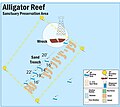This article includes a list of general references, but it lacks sufficient corresponding inline citations .(November 2017) |
| Alligator Reef | |
|---|---|
| Location | |
| Location | Caribbean |
| Coordinates | 24°50′50″N080°37′11″W / 24.84722°N 80.61972°W |
| Country | United States |
| Geology | |
| Type | reef |
Alligator Reef is a coral reef located within the Florida Keys National Marine Sanctuary. It lies to the southeast of Upper Matecumbe Key. This reef lies within a Sanctuary Preservation Area (SPA).






